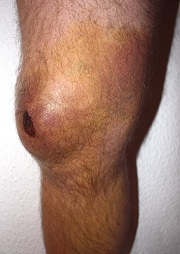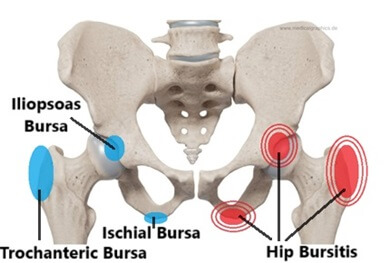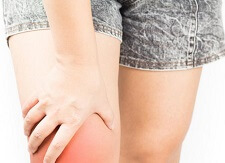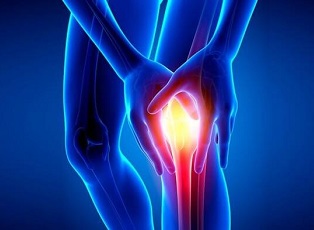- Home
- Common Knee Conditions
- Bursitis
Knee Bursitis
Written By: Chloe Wilson, BSc(Hons) Physiotherapy
Reviewed by: KPE Medical Review Board
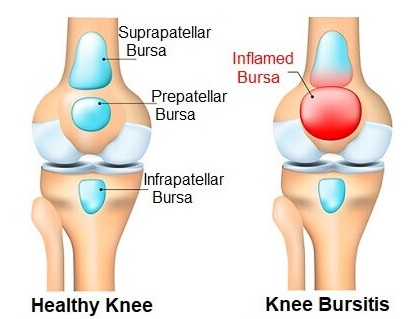
Knee bursitis occurs when there is irritation or inflammation in one of the knee bursa.
Bursa are small fluid filled sacs that reduce the friction between two surfaces. They are found all over the body, and sit between bones and muscles, a bit like ball bearings.
They allow the muscles to move freely as they contract and relax without being subjected to too much strain or friction.
Bursitis of the knee results in pain and swelling, most commonly just below, behind or on the side of the knee.
Here, we will look at the following aspects of knee bursitis:
- Causes of Knee Bursitis
- Common Symptoms
- Locations of Knee Bursitis
- Knee Bursitis Treatment
- Recovery Process
Causes of Knee Bursitis
Common causes of knee bursitis include:
- Repetitive Impact: A common cause of knee bursitis is frequent pressure through the bursa. If the knee bursa is repeatedly squashed, e.g. long periods or frequent kneeling or squatting, it responds by producing extra fluid to protect the knee from injury. This causes the bursa to swell resulting in bursitis knee.
- Repetitive Friction: Bursitis knee is often due to repeated friction over the bursa. Activities that involve lots of kicking or jumping such as basketball or soccer where the muscles are frequently rubbing over the bursa as they work can cause irritation and inflammation leading to knee bursitis.
- Muscle Tightness: Another situation where the knee bursa is placed under repeated pressure is when there is muscle tightness. If a muscle is tight, it pushes down on the bursa underneath, squashing it, which can lead to knee bursitis.
- Knee Injury: A sudden, direct blow to the knee, such as a sporting tackle or a car accident, can place sufficient one-time force through the knee bursa that it becomes inflamed.
- Knee Swelling: People with pre-existing knee swelling are at greater risk of developing bursitis knee. Excess fluid in the knee e.g. from a knee injury, arthritis or gout can seep into the bursa, causing it to swell. In fact arthritis is the most common cause of semimembranosus bursitis behind the knee.
Symptoms of Bursitis of The Knee
The most common symptoms of knee bursitis are:
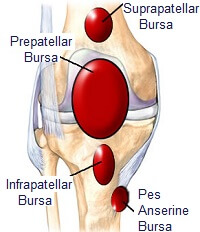
- Localised Knee Pain: bursitis knee pain typically develops gradually, fluctuates and tends to be a general ache rather than sharp knee pain.
- Knee Swelling: People can often feel a squashy lump with a swollen knee bursa which may fluctuate in size.
- Knee Stiffness: It is often painful to bend or straighten a leg with knee bursitis which can limit knee movement.
Symptoms of bursitis knee often come and go and aren't always consistent which can make it hard to accurately diagnose specific knee bursitis. Sometimes it is only once other conditions have been ruled out that bursitis of the knee is finally diagnosed.
Common Types of Knee Bursitis
There are approximately eleven knee bursa located around the joint and bursitis can develop at any one of the bursa knee locations.
The six most common types of knee bursitis are:
1. Prepatellar Bursitis
The prepatellar bursa is found directly in front of the knee cap, just underneath the skin.
Irritation here is known as Prepatellar Bursitis, or more commonly Housemaids Knee, causing pain and swelling at the front of the knee.
Prepatellar knee bursitis is a common problem for people who spend long periods kneeling e.g. carpet layers/roofers because of the continuous pressure going through the prepatellar bursa.
You can find out more about the common causes, symptoms and treatment options in the Housemaids Knee section.
2. Pes Anserine Bursitis
Pes Anserine bursitis occurs on the inner side of the knee. The pes anserine bursa sits between the medial collateral ligament and the conjoined medial knee tendons of the gracilis, sartorius and semitendinosus muscles.
Pes Anserine bursitis of the knee usually develops from overuse and most commonly affects runners.
You can find out more about the common causes, symptoms and best treatment options in the Pes Anserine Bursitis section.
3. Semimembranosus Bursitis
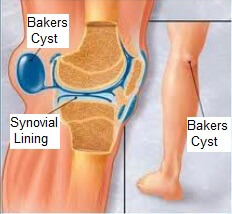
Semimembranosus bursitis causes pain and swelling behind the knee, often resembling a squashy orange, more commonly known as a Bakers Cyst or Popliteal Cyst.
The popliteal bursa sits behind the knee between one of the hamstring tendons, semimembranosus, and the gastrocnemius calf muscle at the back of the knee.
Bursitis behind the knee is usually due to knee injuries or arthritis.
You can find out all about the common causes, symptoms, diagnosis and treatment options in the Bakers Cyst Knee section.
4. Infrapatellar Bursitis
Infrapatellar bursitis occurs just below the kneecap and is often referred to as Clergyman's knee.
There are two knee bursa that may be involved
- Superficial Infrapatellar Bursa: sits between the skin and the patellar tendon
- Deep Infrapatellar Bursa: sits further in behind patellar tendon cushioning it from the shin bone behind.
Swelling of either knee bursa is referred to as infrapatellar bursitis. You can find out loads more about diagnosis and treatment in the infrapatellar bursitis section.
5. Suprapatellar Bursitis
Suprapatellar bursitis causes pain and swelling in the lower thigh, just above the kneecap. The suprapatellar bursa sits between the quadriceps muscle tendon and the patella.
Suprapatellar knee bursitis is usually caused by overuse from sporting activities involving lots of running and jumping, or from frequent kneeling.
You can find out all about the causes, symptoms, diagnosis and treatment options in the suprapatellar bursitis section.
6. Iliotibial Bursitis
Iliotibial bursitis occurs on the outer side of the knee. The iliotibial bursa sits between the iliotibial band and the outer shin bone, just below the knee.
Inflammation of the iliotibial bursa is often misdiagnosed as iliotibial band syndrome.
7. Hip Bursitis
Bursitis can also develop in various bursa around the hip and may refer pain down the thigh towards the knee.
There are three types of hip bursitis:
- Trochanteric Bursitis: Causes outer hip pain
- Iliopsoas Bursitis: Causes front hip and groin pain
- Ischial Bursitis: Causes pain under the sitting bones
Knee Bursitis Treatment
Knee bursitis treatment will vary slightly depending on which bursa is affected but usually involves a combination of:
- Rest: Avoid activities which place pressure through the knee bursa or aggravate your symptoms. LEARN MORE >
- Ice: regularly applying ice can help to reduce bursitis knee pain and swelling. LEARN MORE >
- Medication: anti-inflammatory medication can help reduce knee bursitis pain and swelling
- Aspiration & Injection: If the knee bursa is particularly swollen you doctor may suggest removing the fluid, aspiration, which may be accompanied by an injection of local anaesthetic and corticosteroid to help reduce pain and inflammation. LEARN MORE >
- Stretches: As muscle tightness is often a contributing factor with knee bursitis, it helps to stretch the surrounding muscles out to reduce the pressure and friction through the knee bursa. LEARN MORE >
- Strengthening Exercises: Improving the strength, range and stability of your knee can help reduce knee bursitis symptoms and prevent future build-up of fluid. LEARN MORE >
- Gel Knee Pads: If kneeling down is aggravating your knee bursitis, then wearing gel knee pads can help to cushion the knee and reduce the pressure through the bursa. LEARN MORE >
- Surgery: If symptoms persist in spite of your knee bursitis treatment, which is rare, then your doctor may recommend surgery to remove the affected knee bursa.
#CommissionsEarned from Amazon on qualifying purchases
Recovering From Knee Bursitis
Bursitis knee symptoms usually settle within a few weeks with effective treatment. As mentioned, treatment varies depending on which bursa is affected, and you can find out more about the most common types of bursitis including treatment options and the recovery process:
- Bakers Cyst: back of knee
- Housemaids Knee: front of knee
- Pes Anserine Bursitis: inner side of knee
- Infrapatellar Bursitis: below the knee
- Suprapatellar Bursitis: above the knee
- Trochanteric Bursitis: outer side of hip
- Iliopsoas Bursitis: front of hip
- Ischial Bursitis: back of hip
How To Avoid Bursitis of the Knee
With any problem, prevention is better than cure. The best things you can do to avoid knee bursitis are to:
- Combat Muscle Imbalance: Ensure there is no muscle imbalance in the leg i.e. weakness or tightness.
Knee Stretches: ensure the muscles aren’t putting the bursa under any extra strain
Knee Strengthening Exercises: ensure the forces go through joint correctly without putting extra pressure on the bursa. - Gel Knee Pads: Wear Gel knee pads if kneeling for prolonged periods. Gel Knee Pads reduce the forces going through the joint when kneeling and eliminate friction on the bursa.
If knee bursitis isn't sounding quite like your problem, visit the knee pain diagnosis section for helping working out what is wrong and the best way to treat your pain and stop it coming back.
You may also be interested in the following articles:
- Swelling Above The Knee
- Swelling Behind The Knee
- Font Knee Pain
- Inner Knee Pain
- How To Do Stairs With Knee Pain
- Knee Pain At Night
- Hip Bursitis
Related Articles
Page Last Updated: March 25th, 2025
Next Review Due: March 25th, 2027
